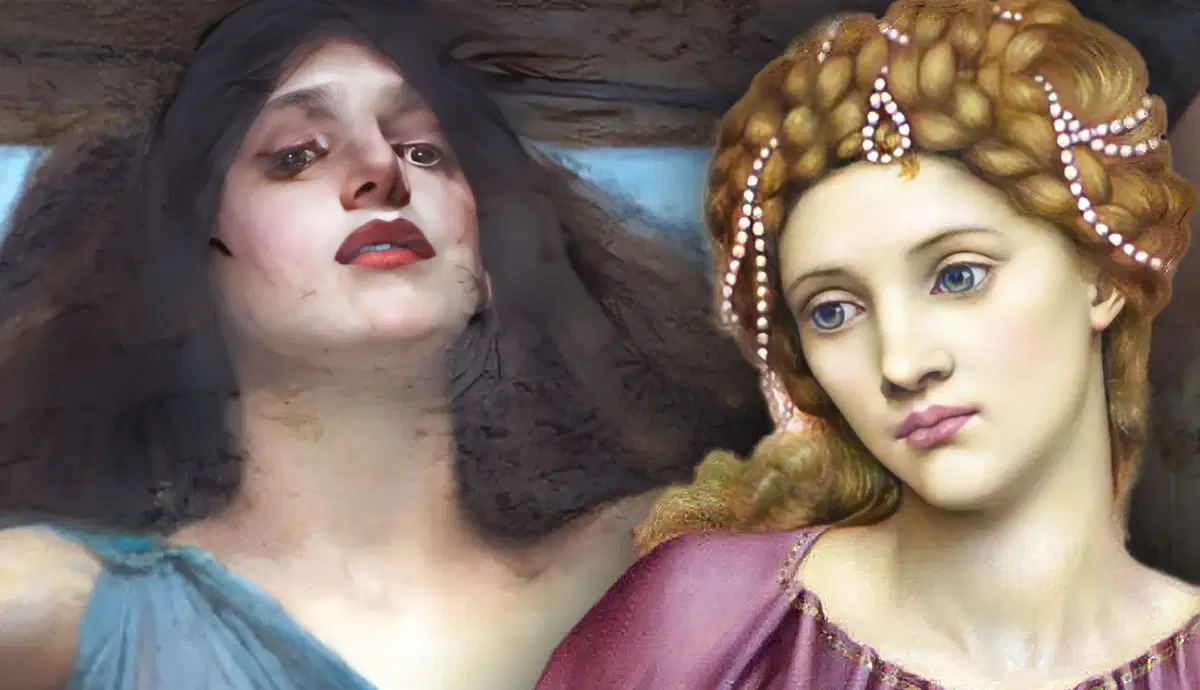
Greek mythology is rich with a pantheon of gods, goddesses, and divine figures, each with their own stories and unique depictions. Two goddesses who are often compared and find themselves entwined are Hecate, the goddess of magic, and Persephone, the goddess of spring. Although they are not the same deity, both are considered major figures in ancient Greek mythology and share some significant characteristics, symbols, and connections.
Hecate Is the Goddess of Magic

Hecate, also known as Hekate, is best known as the goddess of magic, however she is also the goddess of witchcraft, ghosts, necromancy, and crossroads. Some of her sacred symbols include dogs, torches, keys, and the triple moon symbol. As the daughter of Titans, Perses and Asteria, she is also considered a Titan-goddess. Her loyalty to Zeus during Titanmachy spared her from punishment and granted her power after the Olympians defeated and imprisoned the other Titan Gods.
Hecate was often worshiped in nature, much like Persephone, but also as a protector of the household. In Ancient Greece, shrines to her were commonly placed in doorways to ward off evil spirits and protect homes from the dead.
Persephone Is the Goddess of Spring

Persephone, also known as Kore, is not only the goddess of spring but also Queen of the Underworld. She was born to two of the original Olympian gods, Demeter, the goddess of agriculture, and Zeus, King of the Gods. Some of her most notable sacred symbols are pomegranates, seeds, and the narcissus flower. Another one of her sacred symbols, that she shares alongside Hecate, is a fiery torch. Persephone was worshiped with Demeter as part of the Eleusinian Mysteries, a cult that included agrarian rituals and the promise of a blessed afterlife.
Both Goddesses Share a Connection to the Underworld

Persephone and Hecate are both chthonic goddesses, meaning they can reside in the Underworld. However, neither goddess dwells there permanently.
Hecate, as the goddess of crossroads and ghosts, is able to easily cross between the earthly world and the Underworld. She can unlock the gates between realms, which includes opening the gates of death. And just as she protects entryways on Earth, she is also a guardian of the boundary that separates the living from the dead.
As Queen of the Underworld, Persephone lives there and rules beside her husband, Hades. However, she only stays in the Underworld during autumn and winter. During spring and summer, she returns to Earth to be with Demeter. Persephone’s split time in the Underworld stems from the famous myth of her abduction by Hades.
Hecate Helped Demeter Search For Persephone

While gathering flowers in a field one day, Persephone was stolen away by Hades and taken to the Underworld. Demeter desperately searched for her missing daughter, but couldn’t find her anywhere. After Demeter searched for nine days, Hecate finally came to her with a torch in hand. Although she didn’t know who had taken Persephone, she offered her help. In some versions of the myth, she is the only god to offer any help to Demeter. The Homeric “Hymn To Demeter” relays that after Persephone returned to Earth, Hecate embraced her and even became her companion in the Underworld.
Persephone and Hecate Are Goddesses of Transition and Change

As the goddess of transitions and crossroads, Hecate was depicted as a guide that appeared to those embarking on a journey or making major decisions, and she was often relied upon for clarity during these life changes. As for Persephone, her descent to the Underworld is responsible for the cyclical transformation of seasons each year, the greatest transition of the natural world.
Each goddess’ connection with the Underworld also ties them to the mortal transition from life to death. They serve as a reminder of the inevitability of these changes — from Hecate’s constant presence at crossroads to Persephone’s annual influence over the seasons.
Both Are Included in Depictions of the Triple Goddess

The triple goddess embodies the cycle of womanhood and represents the Maiden, the Mother, and the Crone. Some versions of the triple-bodied goddess depict Hecate as the embodiment of all three, while other versions designate Persephone as the Maiden, Demeter as the Mother, and Hecate as the Crone. The name “Persephone” translates to “destroyer” or “bringer of death.” But her other name, “Kore”, actually translates to “maiden,” which is a reference to her life before Hades’ abduction as a virginal nature goddess.
Although Hecate and Persephone are two very distinct goddesses with their own unique characteristics, stories, and symbols, they are often associated with each other. From their companionship in the Underworld to their shared association with the triple-bodied goddess, there is much that ties these two divine figures together in mythology.










